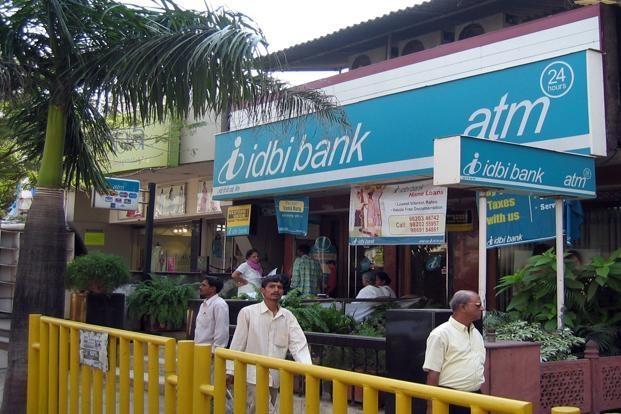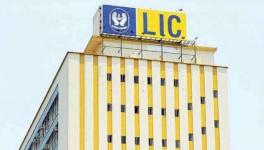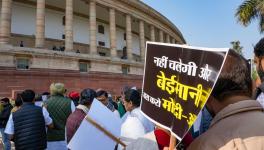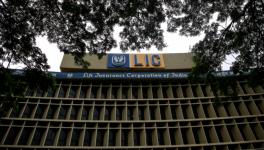IDBI-LIC – Another Disaster In The Making

Today, India’s insurance sector regulator, the IRDAI, gave its nod to LIC buying 51% of shares of the sinking IDBI Bank setting the stage for the first public sector bank to go out of the govt.’s direct control. LIC holds 11% of IDBI Bank’s shares at present while the govt. held the rest.
With this move, the Modi govt. has deviously managed to get rid of the most debt-ridden bank with 28% bad loans, while netting several thousand crore rupees which it can use to meet its disinvestment target of Rs.80,000 crore for this year and bolster its kitty.
It also seems to be paving the way for ultimate privatisation of the IDBI Bank, which is the only public sector bank not covered under the Bank Nationalisation Act (apart from SBI which has its own Act). This privatisation will probably happen 2-3 years down the line as LIC will sell its shares to bring them down to the 15% allowed by the IRDAI.
LIC, India’s largest insurer, has been used by the govt. several times in the past to bail itself out – because LIC has a huge cash pile, nearly Rs.30 lakh crore in assets. It was used to give soft loans to the Railways, subscribed to the power sector’s Ujwal Discom Assurance Yojana (UDAY) bonds and to invest in the National Investment and Infrastructure Fund. It has also been used to step in with bulk purchases of shares for faltering IPOs of Coal India and ONGC. Two years ago, LIC’s cash chest was used to buy 10-14% equity of various public sector banks.
But by practically forcing LIC to bail out a bank, the govt. has stepped into uncharted and potentially dangerous territory. It is allowing the largest insurer – with a base of over 300 million policies and an annual premium of a little over Rs 3 lakh crore – to enter the banking sector that is plagued by mounting bad loans. There is always a risk of contagion – as so dramatically demonstrated in the financial crisis of 2007-8 in the West – and India can little afford to face up to that situation. Have a look at the mess that is IDBI Bank, which the govt. is merrily pushing LIC to take over.
A Short History of IDBI
In 2003, the then NDA govt. led by Atal Bihari Vajpayee had taken over the private Industrial and Development Bank of India (IDBI) and made it the public sector IDBI Bank through an Act.
In 2017-18, IDBI Bank’s gross NPA (bad loans) rose to 27.95%, up from 21.25% in the previous year. In absolute terms, the bank’s gross NPAs touched a staggering Rs 55,588.26 crore. It reported a net loss of Rs 8,238 crore in 2017-18, up from Rs 5,158 crore in 2016-17. Most of its bad loans are in steel, textiles and construction sectors. This was despite a govt. bail out worth Rs 7,881 crore in May this year, which meant that the govt. stake went up to 85.96% in IDBI Bank.
Why was IDBI Bank in such a mess? Last year, the Public Accounts Committee (PAC) of Lok Sabha, in its 78thReport, expressed shock at the state of IDBI Bank’s affairs. In 2004, after taking over the rotting bank, the govt. had set up a Stressed Assets Stabilisation Fund (SASF) to recover its bad loans at that time. Initially, 636 non-performing assets (NPAs) with a net loan outstanding (NLO) of Rs.9,004 crore of IDBI Bank were put under SASF and the govt. provided Rs.9,000 crore to SASF, which in turn were invested in government securities, redeemable in 20 years and pledged back in securities with IDBI. However, as on FY2015-16, government securities of only Rs.4,515 crore were redeemed leaving a balance of Rs.4,486 crore.
Observing 21 settled cases of bad loans, PAC said that NLO for these was Rs.1,144.64 crore but recovery was lower by Rs.587.47 crore. In other words, Rs. 557.17 crore were written off and cases settled. Quoting a CAG report, the PAC said that in 36 out of 39 unresolved cases selected by Audit for examination, the SASF could recover only Rs.150.54 crore as against NLO of Rs.1,888.69 crore, indicating that short recovery in these cases was to the tune of Rs.1,738.14 crore.
"The Committee is shocked to note that in less than 20 years after the government cleared the balance sheet of IDBI, it has again fallen into debt trap of NPA. The Committee is of the considered opinion that the huge NPA of the PSBs point towards their faulty lending policies," the PAC said in its report.
Risk to LIC Policy Holders
Although LIC is a giant and the estimated Rs.20,000 crore that it will have to invest in IDBI Bank is peanuts compared to its total asset holdings, throwing good money into a sink hole like the IDBI is disastrous policy. If the bank itself can’t recover all the money that it lent out, how is the LIC expected to recover it?
The millions of Indians who invest in LIC do so with the confidence that LIC is not going to invest it in bad loss-making deals of this kind. As mentioned earlier, Modi govt.’s penchant for deploying assets of LIC for all manner of bail outs is creating a condition of suspicion regarding LIC’s investment wisdom. This can be disastrous for the insurer. But the Modi govt. is looking at short term gain for itself while pushing its assets down the drain.
The other risk with LIC takeover of a bank is that the systemic crisis of the banking sector can affect the LIC too. As we now know, gross NPAs of all banks have risen to over Rs.10 lakh crore or about 11.6% of all bank loans, according to the latest Financial Stability Report of the RBI. In fact it has been predicted by the RBI that NPAs will further increase to 12.2% of all loans by March next year.
In such dire circumstances, the entry of LIC into the ailing banking system lays it open to contagion or transfer of risk. LIC will now be saddled with bad loans, while the public will become less confident of its wisdom or financial stability. This is the kind of systemic damage the Modi govt. is causing through its myopic policies.
Privatisation and Disinvestment
LIC will buy the shares of IDBI Bank from the govt. This will mean that the proceeds will go into the govt.’s kitty, being counted as disinvestment proceeds. This essentially means padding up the govt.’s revenue and also burnishing its credentials as a govt. committed to privatisation, something that Washington and the captains of industry in India will be happy with. The disaster of the proposed Air India privatisation – nobody turned up at the sale – will thus be slightly compensated. The govt. will move towards its own target of selling off Rs.80,000 crore worth of national assets this year.
Also, with the regulator demanding that insurance companies keep their stake in banks at 15%, the exception made for LIC to buy out IDBI Bank will have to be time bound. LIC will want to sell its stake of 51% to come back to the below 15% limit. Who will it sell the stake to? Not the govt. because it is the govt. only that has sold it to LIC. In all probability, it will be sold to private entities.
This two-step privatisation is the proverbial test case or the canary in the mine. If it works, well and good. A new device for privatisation would have emerged. If not, then LIC will be left holding the baby.
Get the latest reports & analysis with people's perspective on Protests, movements & deep analytical videos, discussions of the current affairs in your Telegram app. Subscribe to NewsClick's Telegram channel & get Real-Time updates on stories, as they get published on our website.
























